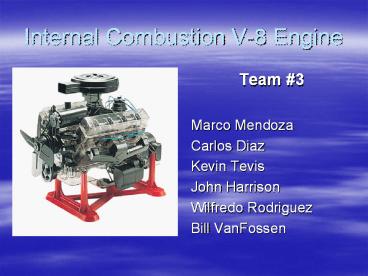Internal Combustion V-8 Engine - PowerPoint PPT Presentation
1 / 11
Title:
Internal Combustion V-8 Engine
Description:
Internal Combustion V-8 Engine Team #3 Marco Mendoza Carlos Diaz Kevin Tevis John Harrison Wilfredo Rodriguez Bill VanFossen Otto cycle Adiabatic 4 step process V-8 ... – PowerPoint PPT presentation
Number of Views:229
Avg rating:3.0/5.0
Title: Internal Combustion V-8 Engine
1
Internal Combustion V-8 Engine
- Team 3
- Marco Mendoza
- Carlos Diaz
- Kevin Tevis
- John Harrison
- Wilfredo Rodriguez
- Bill VanFossen
2
Otto cycle
- Adiabatic 4 step process
Intake piston moves downward, creating a vacuum
which forces the air fuel mixture into the
cylinder. Compression Piston reaches bottom
dead center and the intake valve closes. Piston
begins to move to top dead center. Power piston
reaches top dead center and spark plug ignites
air fuel mixture causing a combustion which
forces piston back down. Exhaust piston reaches
bottom dead center, exhaust valve opens, piston
moves back to top dead center, forcing exhaust
out of cylinder.
3
V-8 Internal combustion engine
- Carbureted
- Eight cylinders
- 16 valve push rod
- Piston orientation 90 degree apart
- Hemispherical combustion chamber
- Single over head cam design (SOHC)
4
Advantages of V8
Disadvantages of V8
- Increased Horsepower due to 8 combustion
chambers. - Increased torque due to longer stroke
- Power conservation Push rod driven engines do
not deplete power as in the belt driven designs. - Less complex (SOHC design)
- High packing efficiency compared to inline engine
- Carburetor not as fuel efficient as fuel
injectors - Heavy
- In comparison to other valve trains, push rods
are not as efficient. - More emissions
5
Cylinder Block assembly
- Typically cast from iron or aluminum
- Encases crankshaft, connecting rods, pistons.
- Main structural component of engine, responsible
for driving flywheel and other components of
vehicle.
6
Crankshaft
- Comprised of eight counterweights
- Converts vertical motion of pistons to circular
motion of shaft, which drives the flywheel and
eventually the wheels of the vehicle. - Attached to the Flywheel and the timing gear
- Connecting rod is fixed to the crankshaft by the
main bearing cap.
7
Cylinder head
- Encases the camshaft, valves, pushrods, and
rocker assembly. - Connected to the intake and exhaust manifold.
- Typically cast from iron or aluminum
- Together with the head gasket, a seal is formed
that allows for high compression
8
Valve train
- Composed of valves, camshaft, rocker arms, rocker
shafts, pushrods. - Allows engine to breath when in sync with
crankshaft rotation (responsible for all
strokes).
9
Challenges
- Timing and firing order
- 32 valve/rocker/cam connections
- Complex cylinder head design
- Manufactured pieces inconsistent with model
(pieces didnt fit together) - Cheap plastic model
- Dimensions difficult to measure
- Model design inconsistent with actual V8 engine
design.
10
Working Assembly
11
Possible Improvements
- Spring-less valve trains Friction losses and
spring forces can reduce engine output up to 25
possible solutions are solenoids and desmodromic
valves. - Fuel Injection system Produces more power than
carbureted engine. Also results in better fuel
efficiency and less emissions.































